A Report on Modernizing Waste Disposal Rate in Australia - Research
VerifiedAdded on 2023/04/25
|19
|4526
|266
Report
AI Summary
This report analyzes the current rate of modernization of waste disposal in Australia, addressing issues associated with the waste disposal system. It discusses modernized methods, including enhanced recycling and automated disposal techniques, highlighting the importance of these advancements due to the exponential increase in waste generation. The research examines the actions taken by the Australian government to ensure safe waste disposal and pollution reduction, focusing on waste disposal issues and mitigation techniques. It reviews literature on the construction industry's environmental impact, waste generation statistics, and the challenges of landfill management. Solutions such as improved recycling processes, automated waste collection, and the development of highly engineered landfills are explored. The methodology involves a positivism research philosophy, an inductive research approach, and qualitative analysis of secondary data from publicly available resources, focusing on government undertakings in waste reduction.
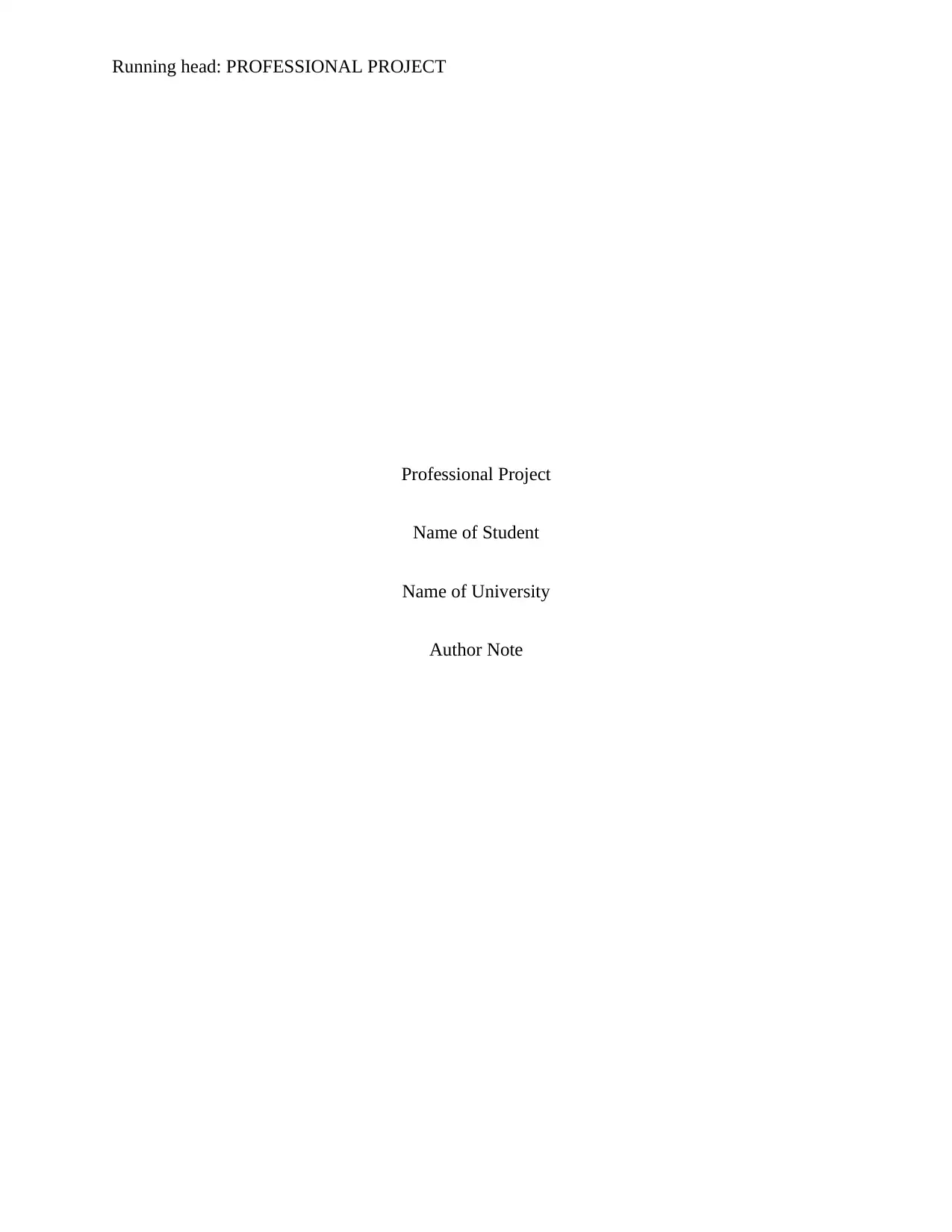
Running head: PROFESSIONAL PROJECT
Professional Project
Name of Student
Name of University
Author Note
Professional Project
Name of Student
Name of University
Author Note
Paraphrase This Document
Need a fresh take? Get an instant paraphrase of this document with our AI Paraphraser
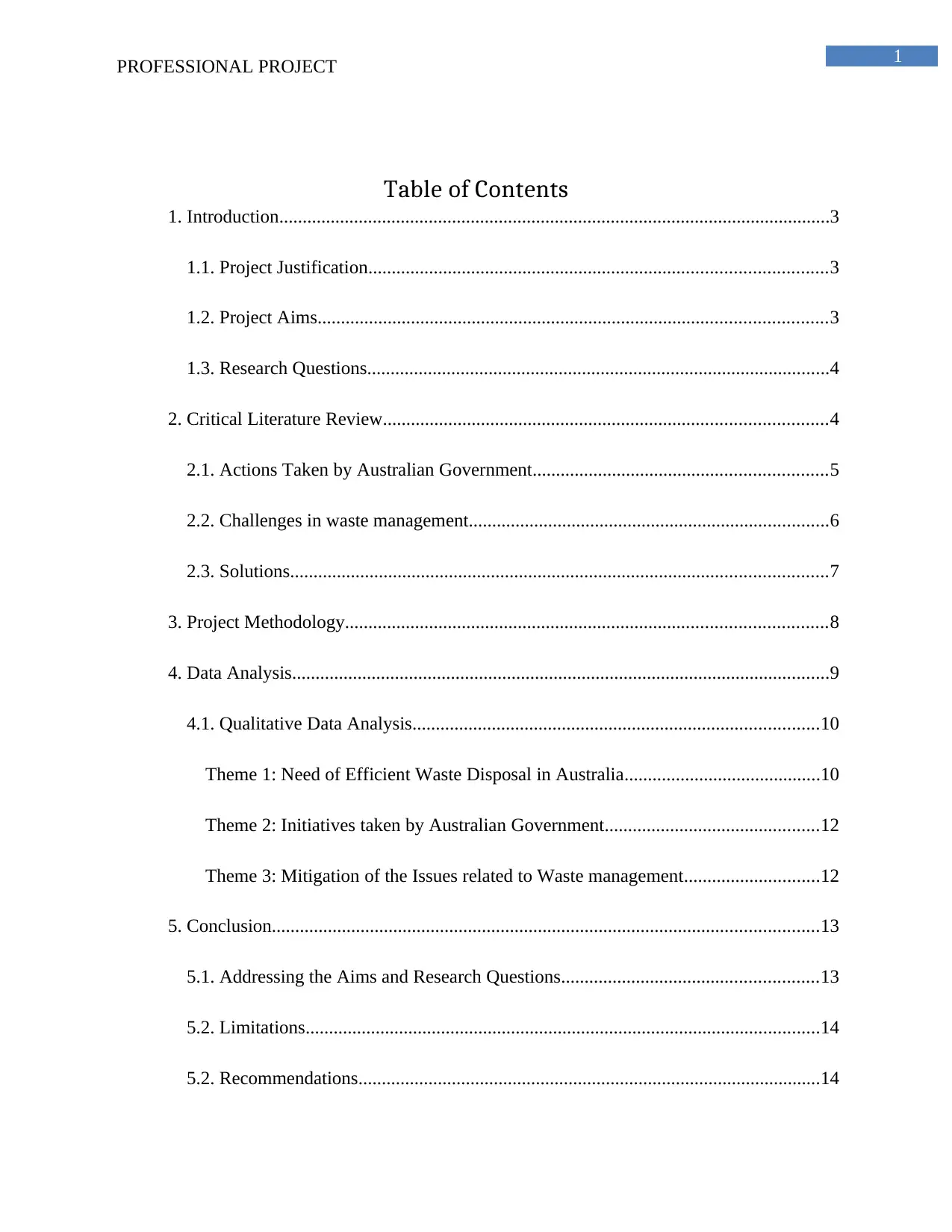
1
PROFESSIONAL PROJECT
Table of Contents
1. Introduction......................................................................................................................3
1.1. Project Justification..................................................................................................3
1.2. Project Aims.............................................................................................................3
1.3. Research Questions...................................................................................................4
2. Critical Literature Review...............................................................................................4
2.1. Actions Taken by Australian Government...............................................................5
2.2. Challenges in waste management.............................................................................6
2.3. Solutions...................................................................................................................7
3. Project Methodology.......................................................................................................8
4. Data Analysis...................................................................................................................9
4.1. Qualitative Data Analysis.......................................................................................10
Theme 1: Need of Efficient Waste Disposal in Australia..........................................10
Theme 2: Initiatives taken by Australian Government..............................................12
Theme 3: Mitigation of the Issues related to Waste management.............................12
5. Conclusion.....................................................................................................................13
5.1. Addressing the Aims and Research Questions.......................................................13
5.2. Limitations..............................................................................................................14
5.2. Recommendations...................................................................................................14
PROFESSIONAL PROJECT
Table of Contents
1. Introduction......................................................................................................................3
1.1. Project Justification..................................................................................................3
1.2. Project Aims.............................................................................................................3
1.3. Research Questions...................................................................................................4
2. Critical Literature Review...............................................................................................4
2.1. Actions Taken by Australian Government...............................................................5
2.2. Challenges in waste management.............................................................................6
2.3. Solutions...................................................................................................................7
3. Project Methodology.......................................................................................................8
4. Data Analysis...................................................................................................................9
4.1. Qualitative Data Analysis.......................................................................................10
Theme 1: Need of Efficient Waste Disposal in Australia..........................................10
Theme 2: Initiatives taken by Australian Government..............................................12
Theme 3: Mitigation of the Issues related to Waste management.............................12
5. Conclusion.....................................................................................................................13
5.1. Addressing the Aims and Research Questions.......................................................13
5.2. Limitations..............................................................................................................14
5.2. Recommendations...................................................................................................14
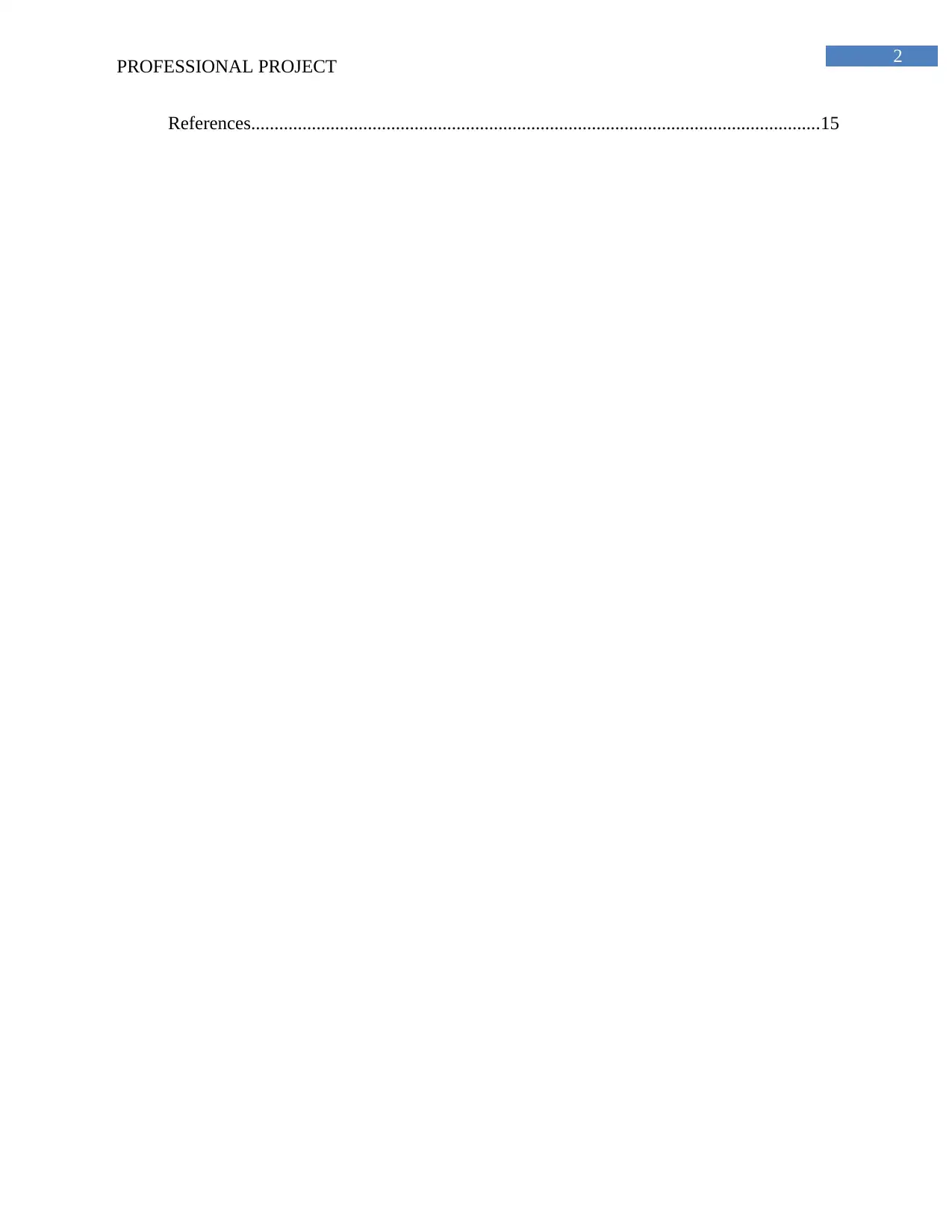
2
PROFESSIONAL PROJECT
References..........................................................................................................................15
PROFESSIONAL PROJECT
References..........................................................................................................................15
⊘ This is a preview!⊘
Do you want full access?
Subscribe today to unlock all pages.

Trusted by 1+ million students worldwide
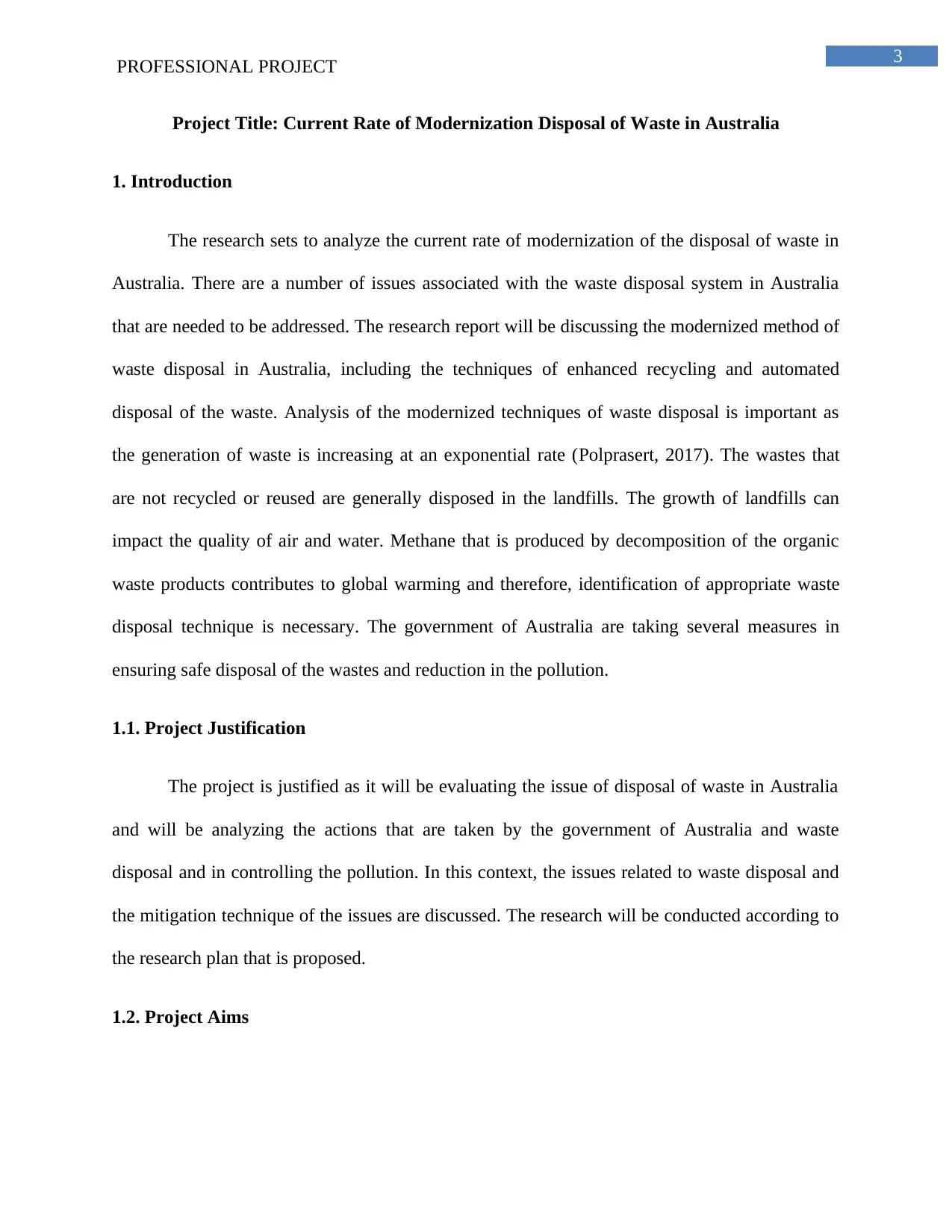
3
PROFESSIONAL PROJECT
Project Title: Current Rate of Modernization Disposal of Waste in Australia
1. Introduction
The research sets to analyze the current rate of modernization of the disposal of waste in
Australia. There are a number of issues associated with the waste disposal system in Australia
that are needed to be addressed. The research report will be discussing the modernized method of
waste disposal in Australia, including the techniques of enhanced recycling and automated
disposal of the waste. Analysis of the modernized techniques of waste disposal is important as
the generation of waste is increasing at an exponential rate (Polprasert, 2017). The wastes that
are not recycled or reused are generally disposed in the landfills. The growth of landfills can
impact the quality of air and water. Methane that is produced by decomposition of the organic
waste products contributes to global warming and therefore, identification of appropriate waste
disposal technique is necessary. The government of Australia are taking several measures in
ensuring safe disposal of the wastes and reduction in the pollution.
1.1. Project Justification
The project is justified as it will be evaluating the issue of disposal of waste in Australia
and will be analyzing the actions that are taken by the government of Australia and waste
disposal and in controlling the pollution. In this context, the issues related to waste disposal and
the mitigation technique of the issues are discussed. The research will be conducted according to
the research plan that is proposed.
1.2. Project Aims
PROFESSIONAL PROJECT
Project Title: Current Rate of Modernization Disposal of Waste in Australia
1. Introduction
The research sets to analyze the current rate of modernization of the disposal of waste in
Australia. There are a number of issues associated with the waste disposal system in Australia
that are needed to be addressed. The research report will be discussing the modernized method of
waste disposal in Australia, including the techniques of enhanced recycling and automated
disposal of the waste. Analysis of the modernized techniques of waste disposal is important as
the generation of waste is increasing at an exponential rate (Polprasert, 2017). The wastes that
are not recycled or reused are generally disposed in the landfills. The growth of landfills can
impact the quality of air and water. Methane that is produced by decomposition of the organic
waste products contributes to global warming and therefore, identification of appropriate waste
disposal technique is necessary. The government of Australia are taking several measures in
ensuring safe disposal of the wastes and reduction in the pollution.
1.1. Project Justification
The project is justified as it will be evaluating the issue of disposal of waste in Australia
and will be analyzing the actions that are taken by the government of Australia and waste
disposal and in controlling the pollution. In this context, the issues related to waste disposal and
the mitigation technique of the issues are discussed. The research will be conducted according to
the research plan that is proposed.
1.2. Project Aims
Paraphrase This Document
Need a fresh take? Get an instant paraphrase of this document with our AI Paraphraser
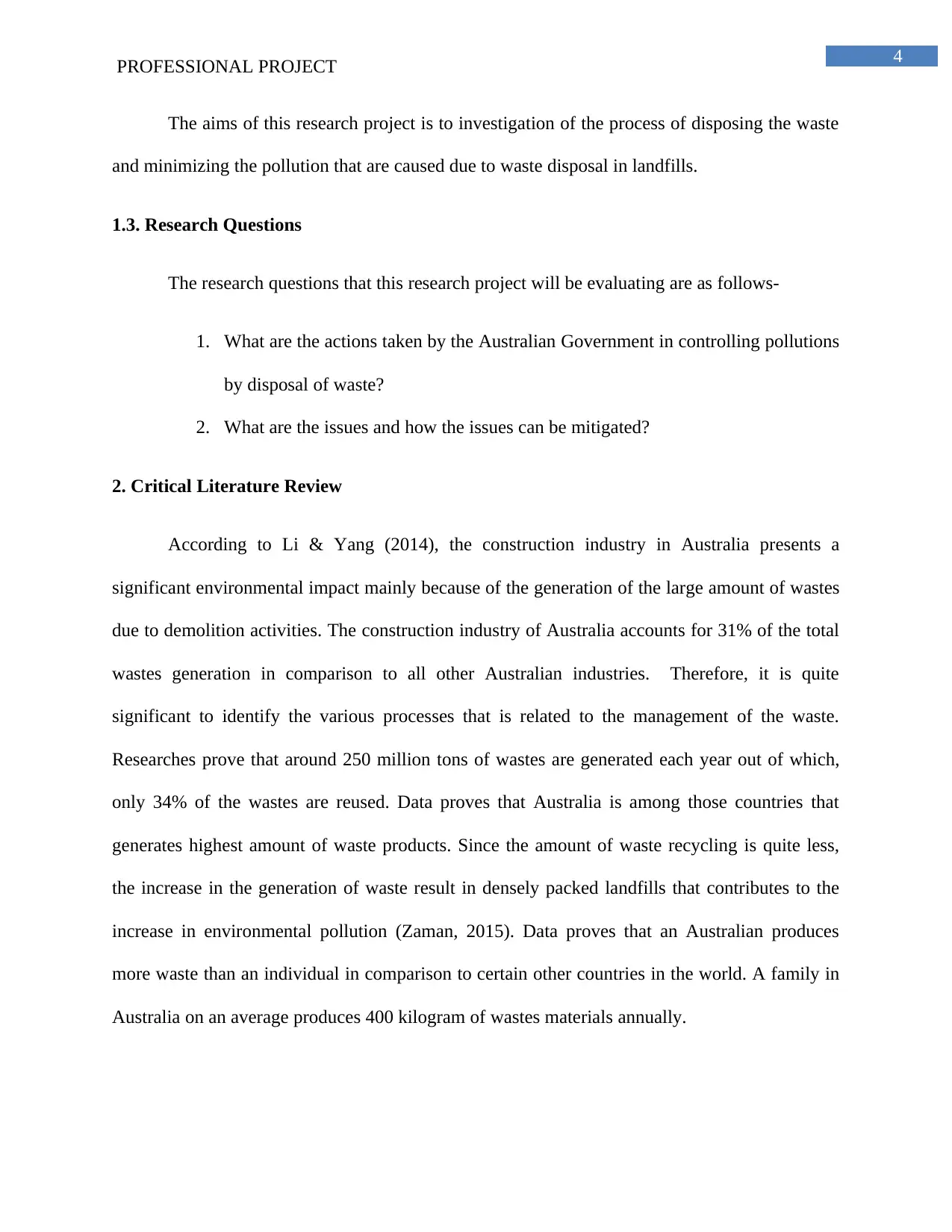
4
PROFESSIONAL PROJECT
The aims of this research project is to investigation of the process of disposing the waste
and minimizing the pollution that are caused due to waste disposal in landfills.
1.3. Research Questions
The research questions that this research project will be evaluating are as follows-
1. What are the actions taken by the Australian Government in controlling pollutions
by disposal of waste?
2. What are the issues and how the issues can be mitigated?
2. Critical Literature Review
According to Li & Yang (2014), the construction industry in Australia presents a
significant environmental impact mainly because of the generation of the large amount of wastes
due to demolition activities. The construction industry of Australia accounts for 31% of the total
wastes generation in comparison to all other Australian industries. Therefore, it is quite
significant to identify the various processes that is related to the management of the waste.
Researches prove that around 250 million tons of wastes are generated each year out of which,
only 34% of the wastes are reused. Data proves that Australia is among those countries that
generates highest amount of waste products. Since the amount of waste recycling is quite less,
the increase in the generation of waste result in densely packed landfills that contributes to the
increase in environmental pollution (Zaman, 2015). Data proves that an Australian produces
more waste than an individual in comparison to certain other countries in the world. A family in
Australia on an average produces 400 kilogram of wastes materials annually.
PROFESSIONAL PROJECT
The aims of this research project is to investigation of the process of disposing the waste
and minimizing the pollution that are caused due to waste disposal in landfills.
1.3. Research Questions
The research questions that this research project will be evaluating are as follows-
1. What are the actions taken by the Australian Government in controlling pollutions
by disposal of waste?
2. What are the issues and how the issues can be mitigated?
2. Critical Literature Review
According to Li & Yang (2014), the construction industry in Australia presents a
significant environmental impact mainly because of the generation of the large amount of wastes
due to demolition activities. The construction industry of Australia accounts for 31% of the total
wastes generation in comparison to all other Australian industries. Therefore, it is quite
significant to identify the various processes that is related to the management of the waste.
Researches prove that around 250 million tons of wastes are generated each year out of which,
only 34% of the wastes are reused. Data proves that Australia is among those countries that
generates highest amount of waste products. Since the amount of waste recycling is quite less,
the increase in the generation of waste result in densely packed landfills that contributes to the
increase in environmental pollution (Zaman, 2015). Data proves that an Australian produces
more waste than an individual in comparison to certain other countries in the world. A family in
Australia on an average produces 400 kilogram of wastes materials annually.
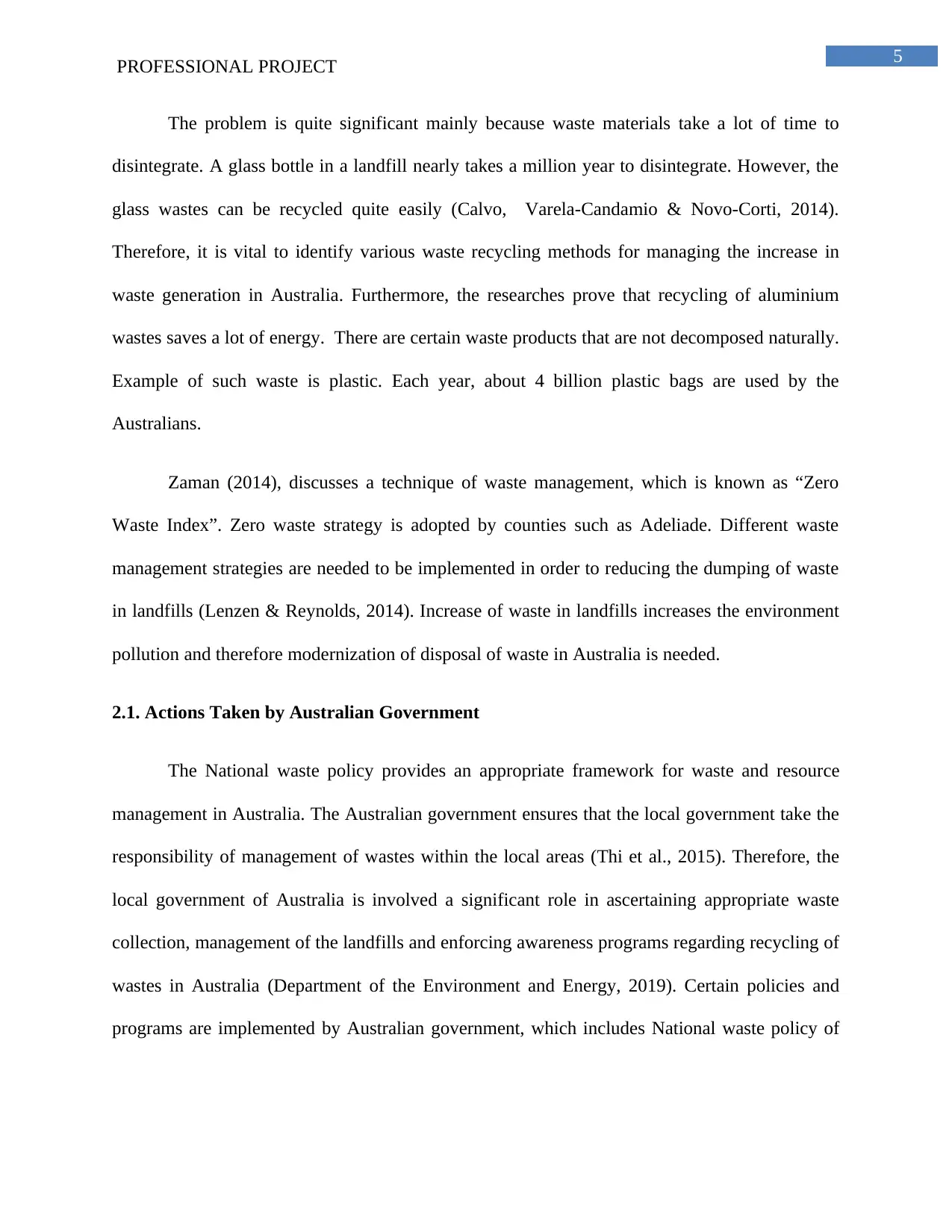
5
PROFESSIONAL PROJECT
The problem is quite significant mainly because waste materials take a lot of time to
disintegrate. A glass bottle in a landfill nearly takes a million year to disintegrate. However, the
glass wastes can be recycled quite easily (Calvo, Varela-Candamio & Novo-Corti, 2014).
Therefore, it is vital to identify various waste recycling methods for managing the increase in
waste generation in Australia. Furthermore, the researches prove that recycling of aluminium
wastes saves a lot of energy. There are certain waste products that are not decomposed naturally.
Example of such waste is plastic. Each year, about 4 billion plastic bags are used by the
Australians.
Zaman (2014), discusses a technique of waste management, which is known as “Zero
Waste Index”. Zero waste strategy is adopted by counties such as Adeliade. Different waste
management strategies are needed to be implemented in order to reducing the dumping of waste
in landfills (Lenzen & Reynolds, 2014). Increase of waste in landfills increases the environment
pollution and therefore modernization of disposal of waste in Australia is needed.
2.1. Actions Taken by Australian Government
The National waste policy provides an appropriate framework for waste and resource
management in Australia. The Australian government ensures that the local government take the
responsibility of management of wastes within the local areas (Thi et al., 2015). Therefore, the
local government of Australia is involved a significant role in ascertaining appropriate waste
collection, management of the landfills and enforcing awareness programs regarding recycling of
wastes in Australia (Department of the Environment and Energy, 2019). Certain policies and
programs are implemented by Australian government, which includes National waste policy of
PROFESSIONAL PROJECT
The problem is quite significant mainly because waste materials take a lot of time to
disintegrate. A glass bottle in a landfill nearly takes a million year to disintegrate. However, the
glass wastes can be recycled quite easily (Calvo, Varela-Candamio & Novo-Corti, 2014).
Therefore, it is vital to identify various waste recycling methods for managing the increase in
waste generation in Australia. Furthermore, the researches prove that recycling of aluminium
wastes saves a lot of energy. There are certain waste products that are not decomposed naturally.
Example of such waste is plastic. Each year, about 4 billion plastic bags are used by the
Australians.
Zaman (2014), discusses a technique of waste management, which is known as “Zero
Waste Index”. Zero waste strategy is adopted by counties such as Adeliade. Different waste
management strategies are needed to be implemented in order to reducing the dumping of waste
in landfills (Lenzen & Reynolds, 2014). Increase of waste in landfills increases the environment
pollution and therefore modernization of disposal of waste in Australia is needed.
2.1. Actions Taken by Australian Government
The National waste policy provides an appropriate framework for waste and resource
management in Australia. The Australian government ensures that the local government take the
responsibility of management of wastes within the local areas (Thi et al., 2015). Therefore, the
local government of Australia is involved a significant role in ascertaining appropriate waste
collection, management of the landfills and enforcing awareness programs regarding recycling of
wastes in Australia (Department of the Environment and Energy, 2019). Certain policies and
programs are implemented by Australian government, which includes National waste policy of
⊘ This is a preview!⊘
Do you want full access?
Subscribe today to unlock all pages.

Trusted by 1+ million students worldwide
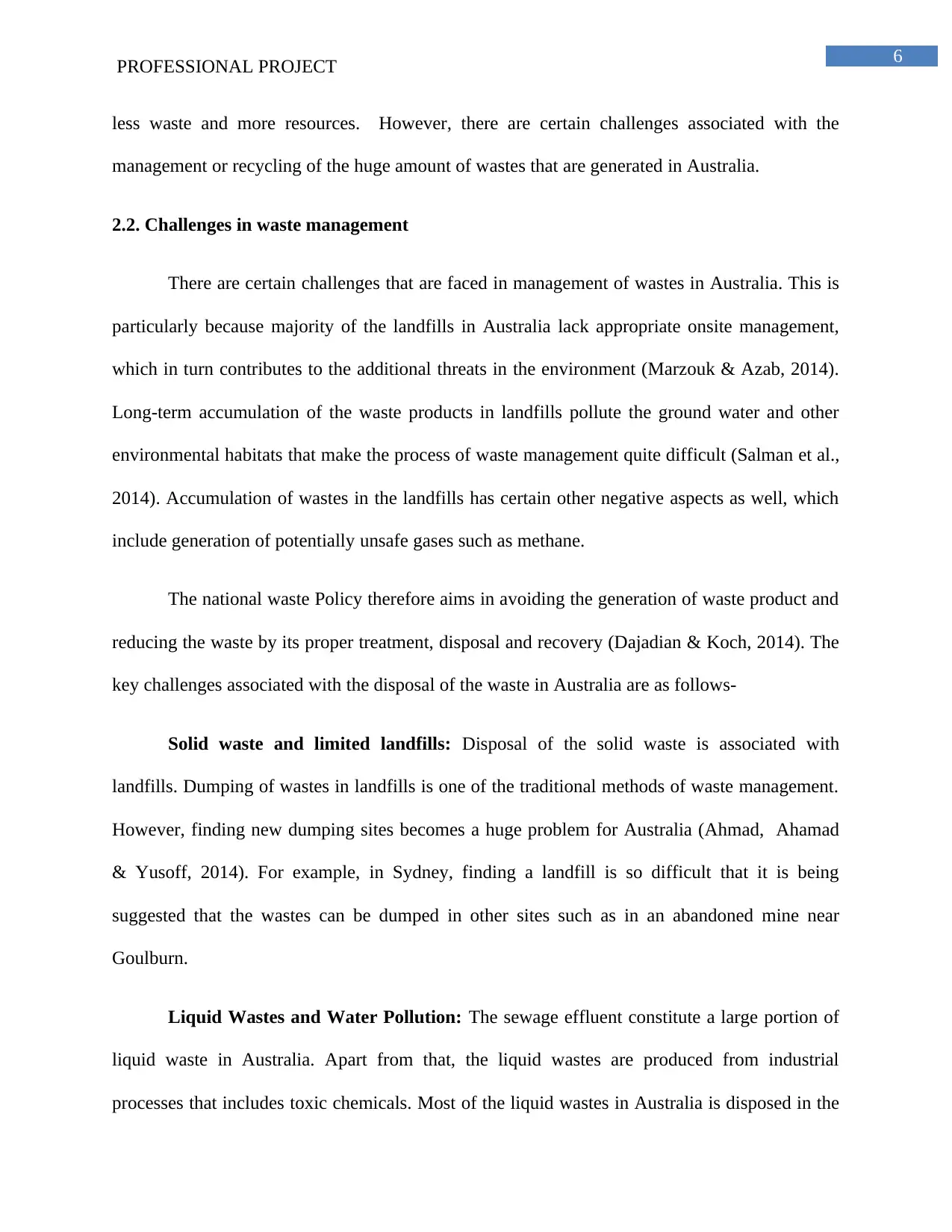
6
PROFESSIONAL PROJECT
less waste and more resources. However, there are certain challenges associated with the
management or recycling of the huge amount of wastes that are generated in Australia.
2.2. Challenges in waste management
There are certain challenges that are faced in management of wastes in Australia. This is
particularly because majority of the landfills in Australia lack appropriate onsite management,
which in turn contributes to the additional threats in the environment (Marzouk & Azab, 2014).
Long-term accumulation of the waste products in landfills pollute the ground water and other
environmental habitats that make the process of waste management quite difficult (Salman et al.,
2014). Accumulation of wastes in the landfills has certain other negative aspects as well, which
include generation of potentially unsafe gases such as methane.
The national waste Policy therefore aims in avoiding the generation of waste product and
reducing the waste by its proper treatment, disposal and recovery (Dajadian & Koch, 2014). The
key challenges associated with the disposal of the waste in Australia are as follows-
Solid waste and limited landfills: Disposal of the solid waste is associated with
landfills. Dumping of wastes in landfills is one of the traditional methods of waste management.
However, finding new dumping sites becomes a huge problem for Australia (Ahmad, Ahamad
& Yusoff, 2014). For example, in Sydney, finding a landfill is so difficult that it is being
suggested that the wastes can be dumped in other sites such as in an abandoned mine near
Goulburn.
Liquid Wastes and Water Pollution: The sewage effluent constitute a large portion of
liquid waste in Australia. Apart from that, the liquid wastes are produced from industrial
processes that includes toxic chemicals. Most of the liquid wastes in Australia is disposed in the
PROFESSIONAL PROJECT
less waste and more resources. However, there are certain challenges associated with the
management or recycling of the huge amount of wastes that are generated in Australia.
2.2. Challenges in waste management
There are certain challenges that are faced in management of wastes in Australia. This is
particularly because majority of the landfills in Australia lack appropriate onsite management,
which in turn contributes to the additional threats in the environment (Marzouk & Azab, 2014).
Long-term accumulation of the waste products in landfills pollute the ground water and other
environmental habitats that make the process of waste management quite difficult (Salman et al.,
2014). Accumulation of wastes in the landfills has certain other negative aspects as well, which
include generation of potentially unsafe gases such as methane.
The national waste Policy therefore aims in avoiding the generation of waste product and
reducing the waste by its proper treatment, disposal and recovery (Dajadian & Koch, 2014). The
key challenges associated with the disposal of the waste in Australia are as follows-
Solid waste and limited landfills: Disposal of the solid waste is associated with
landfills. Dumping of wastes in landfills is one of the traditional methods of waste management.
However, finding new dumping sites becomes a huge problem for Australia (Ahmad, Ahamad
& Yusoff, 2014). For example, in Sydney, finding a landfill is so difficult that it is being
suggested that the wastes can be dumped in other sites such as in an abandoned mine near
Goulburn.
Liquid Wastes and Water Pollution: The sewage effluent constitute a large portion of
liquid waste in Australia. Apart from that, the liquid wastes are produced from industrial
processes that includes toxic chemicals. Most of the liquid wastes in Australia is disposed in the
Paraphrase This Document
Need a fresh take? Get an instant paraphrase of this document with our AI Paraphraser
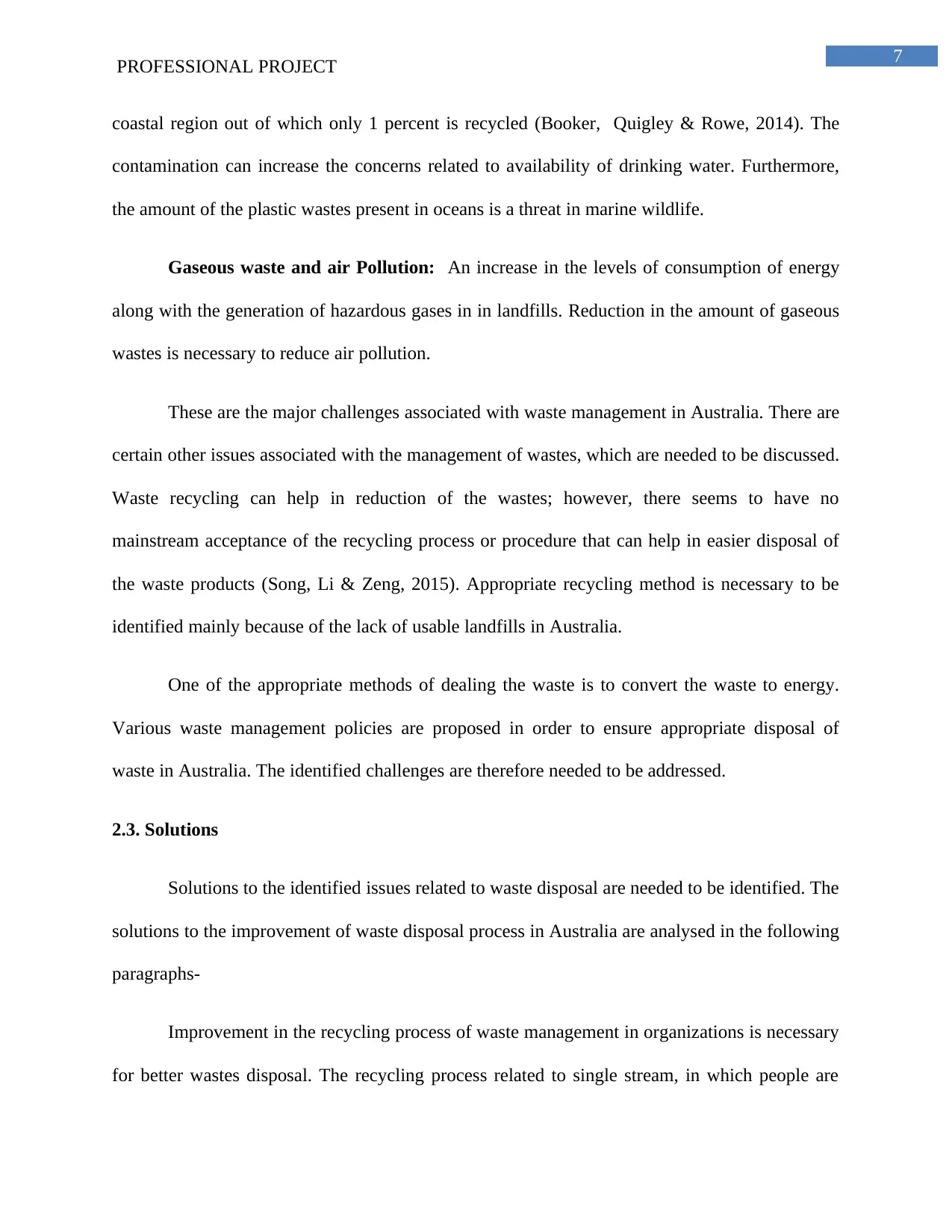
7
PROFESSIONAL PROJECT
coastal region out of which only 1 percent is recycled (Booker, Quigley & Rowe, 2014). The
contamination can increase the concerns related to availability of drinking water. Furthermore,
the amount of the plastic wastes present in oceans is a threat in marine wildlife.
Gaseous waste and air Pollution: An increase in the levels of consumption of energy
along with the generation of hazardous gases in in landfills. Reduction in the amount of gaseous
wastes is necessary to reduce air pollution.
These are the major challenges associated with waste management in Australia. There are
certain other issues associated with the management of wastes, which are needed to be discussed.
Waste recycling can help in reduction of the wastes; however, there seems to have no
mainstream acceptance of the recycling process or procedure that can help in easier disposal of
the waste products (Song, Li & Zeng, 2015). Appropriate recycling method is necessary to be
identified mainly because of the lack of usable landfills in Australia.
One of the appropriate methods of dealing the waste is to convert the waste to energy.
Various waste management policies are proposed in order to ensure appropriate disposal of
waste in Australia. The identified challenges are therefore needed to be addressed.
2.3. Solutions
Solutions to the identified issues related to waste disposal are needed to be identified. The
solutions to the improvement of waste disposal process in Australia are analysed in the following
paragraphs-
Improvement in the recycling process of waste management in organizations is necessary
for better wastes disposal. The recycling process related to single stream, in which people are
PROFESSIONAL PROJECT
coastal region out of which only 1 percent is recycled (Booker, Quigley & Rowe, 2014). The
contamination can increase the concerns related to availability of drinking water. Furthermore,
the amount of the plastic wastes present in oceans is a threat in marine wildlife.
Gaseous waste and air Pollution: An increase in the levels of consumption of energy
along with the generation of hazardous gases in in landfills. Reduction in the amount of gaseous
wastes is necessary to reduce air pollution.
These are the major challenges associated with waste management in Australia. There are
certain other issues associated with the management of wastes, which are needed to be discussed.
Waste recycling can help in reduction of the wastes; however, there seems to have no
mainstream acceptance of the recycling process or procedure that can help in easier disposal of
the waste products (Song, Li & Zeng, 2015). Appropriate recycling method is necessary to be
identified mainly because of the lack of usable landfills in Australia.
One of the appropriate methods of dealing the waste is to convert the waste to energy.
Various waste management policies are proposed in order to ensure appropriate disposal of
waste in Australia. The identified challenges are therefore needed to be addressed.
2.3. Solutions
Solutions to the identified issues related to waste disposal are needed to be identified. The
solutions to the improvement of waste disposal process in Australia are analysed in the following
paragraphs-
Improvement in the recycling process of waste management in organizations is necessary
for better wastes disposal. The recycling process related to single stream, in which people are
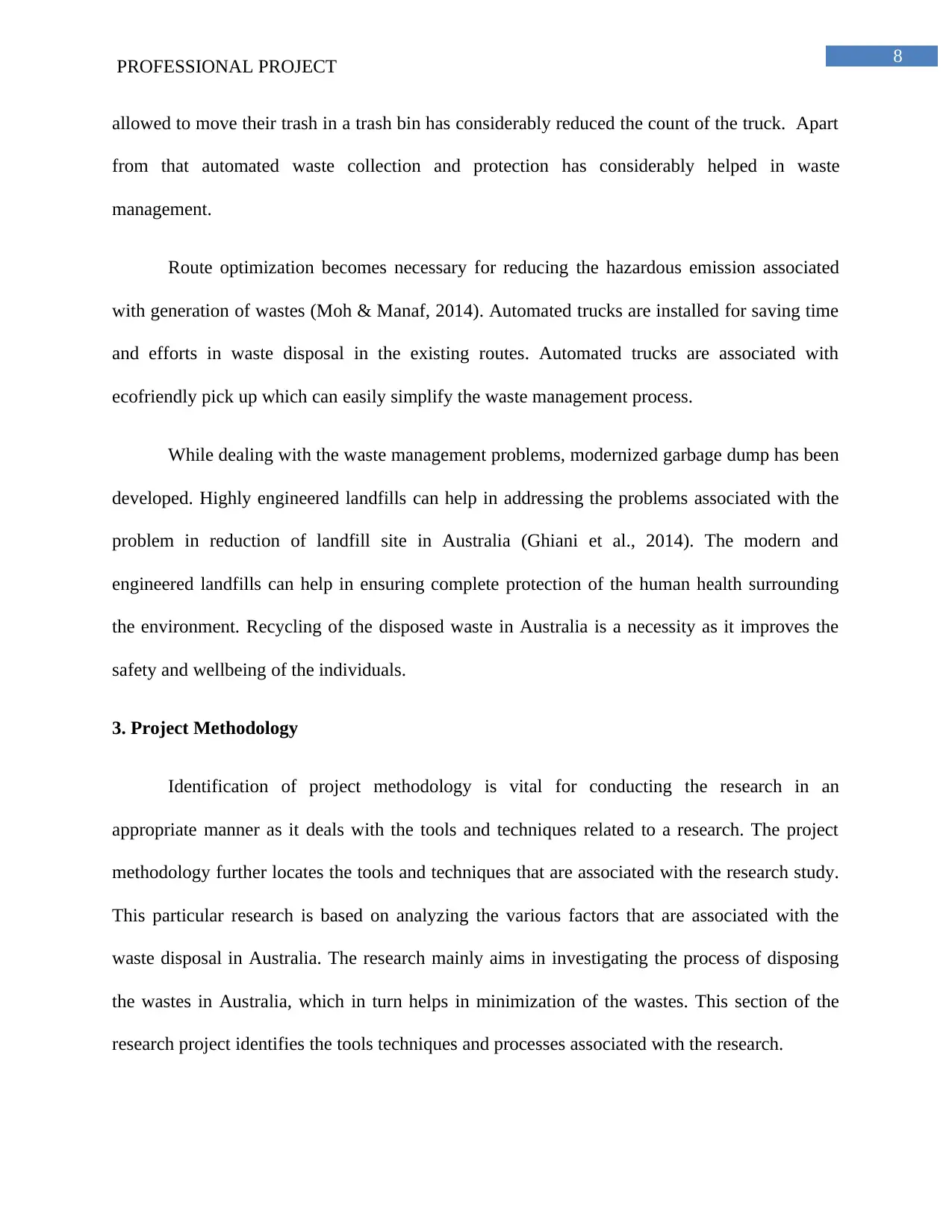
8
PROFESSIONAL PROJECT
allowed to move their trash in a trash bin has considerably reduced the count of the truck. Apart
from that automated waste collection and protection has considerably helped in waste
management.
Route optimization becomes necessary for reducing the hazardous emission associated
with generation of wastes (Moh & Manaf, 2014). Automated trucks are installed for saving time
and efforts in waste disposal in the existing routes. Automated trucks are associated with
ecofriendly pick up which can easily simplify the waste management process.
While dealing with the waste management problems, modernized garbage dump has been
developed. Highly engineered landfills can help in addressing the problems associated with the
problem in reduction of landfill site in Australia (Ghiani et al., 2014). The modern and
engineered landfills can help in ensuring complete protection of the human health surrounding
the environment. Recycling of the disposed waste in Australia is a necessity as it improves the
safety and wellbeing of the individuals.
3. Project Methodology
Identification of project methodology is vital for conducting the research in an
appropriate manner as it deals with the tools and techniques related to a research. The project
methodology further locates the tools and techniques that are associated with the research study.
This particular research is based on analyzing the various factors that are associated with the
waste disposal in Australia. The research mainly aims in investigating the process of disposing
the wastes in Australia, which in turn helps in minimization of the wastes. This section of the
research project identifies the tools techniques and processes associated with the research.
PROFESSIONAL PROJECT
allowed to move their trash in a trash bin has considerably reduced the count of the truck. Apart
from that automated waste collection and protection has considerably helped in waste
management.
Route optimization becomes necessary for reducing the hazardous emission associated
with generation of wastes (Moh & Manaf, 2014). Automated trucks are installed for saving time
and efforts in waste disposal in the existing routes. Automated trucks are associated with
ecofriendly pick up which can easily simplify the waste management process.
While dealing with the waste management problems, modernized garbage dump has been
developed. Highly engineered landfills can help in addressing the problems associated with the
problem in reduction of landfill site in Australia (Ghiani et al., 2014). The modern and
engineered landfills can help in ensuring complete protection of the human health surrounding
the environment. Recycling of the disposed waste in Australia is a necessity as it improves the
safety and wellbeing of the individuals.
3. Project Methodology
Identification of project methodology is vital for conducting the research in an
appropriate manner as it deals with the tools and techniques related to a research. The project
methodology further locates the tools and techniques that are associated with the research study.
This particular research is based on analyzing the various factors that are associated with the
waste disposal in Australia. The research mainly aims in investigating the process of disposing
the wastes in Australia, which in turn helps in minimization of the wastes. This section of the
research project identifies the tools techniques and processes associated with the research.
⊘ This is a preview!⊘
Do you want full access?
Subscribe today to unlock all pages.

Trusted by 1+ million students worldwide
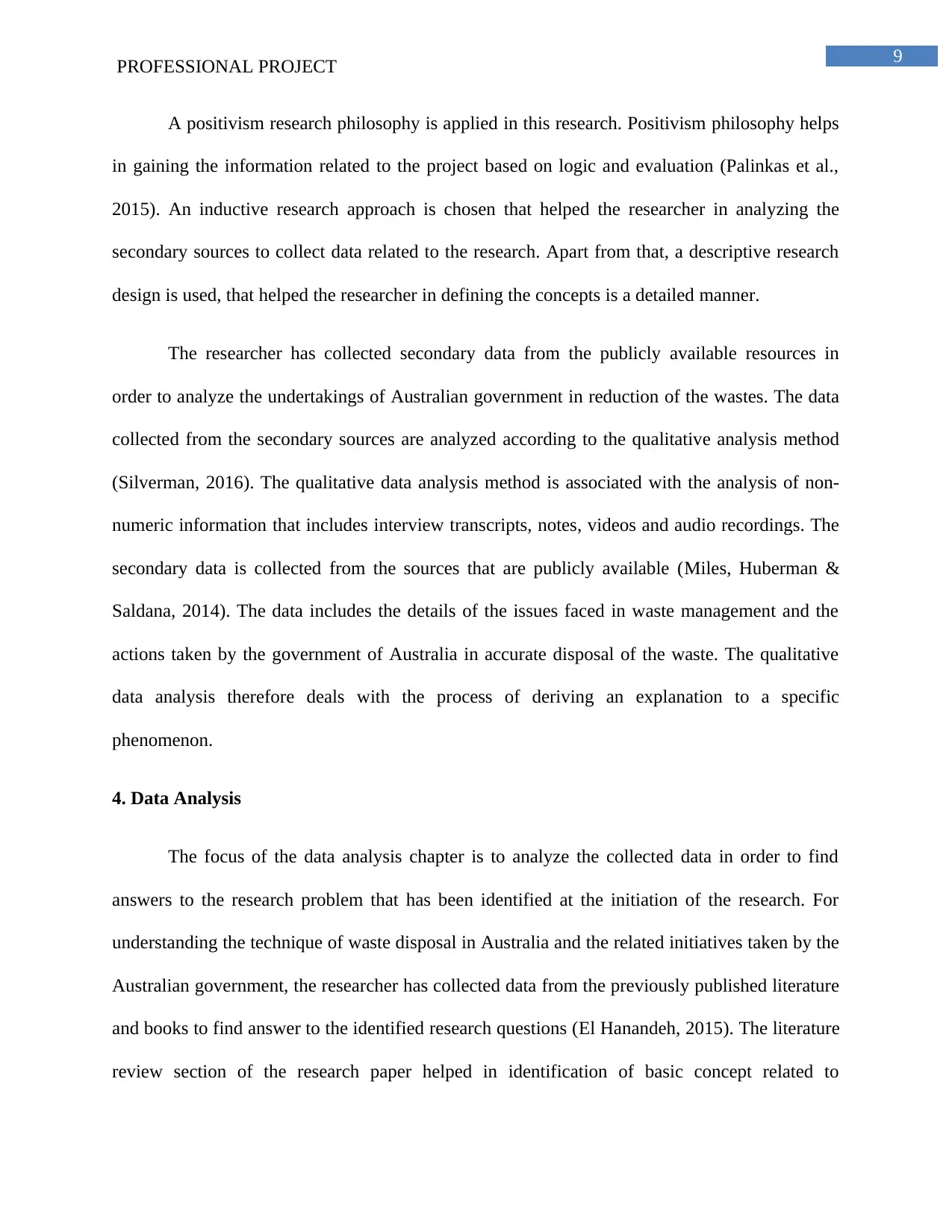
9
PROFESSIONAL PROJECT
A positivism research philosophy is applied in this research. Positivism philosophy helps
in gaining the information related to the project based on logic and evaluation (Palinkas et al.,
2015). An inductive research approach is chosen that helped the researcher in analyzing the
secondary sources to collect data related to the research. Apart from that, a descriptive research
design is used, that helped the researcher in defining the concepts is a detailed manner.
The researcher has collected secondary data from the publicly available resources in
order to analyze the undertakings of Australian government in reduction of the wastes. The data
collected from the secondary sources are analyzed according to the qualitative analysis method
(Silverman, 2016). The qualitative data analysis method is associated with the analysis of non-
numeric information that includes interview transcripts, notes, videos and audio recordings. The
secondary data is collected from the sources that are publicly available (Miles, Huberman &
Saldana, 2014). The data includes the details of the issues faced in waste management and the
actions taken by the government of Australia in accurate disposal of the waste. The qualitative
data analysis therefore deals with the process of deriving an explanation to a specific
phenomenon.
4. Data Analysis
The focus of the data analysis chapter is to analyze the collected data in order to find
answers to the research problem that has been identified at the initiation of the research. For
understanding the technique of waste disposal in Australia and the related initiatives taken by the
Australian government, the researcher has collected data from the previously published literature
and books to find answer to the identified research questions (El Hanandeh, 2015). The literature
review section of the research paper helped in identification of basic concept related to
PROFESSIONAL PROJECT
A positivism research philosophy is applied in this research. Positivism philosophy helps
in gaining the information related to the project based on logic and evaluation (Palinkas et al.,
2015). An inductive research approach is chosen that helped the researcher in analyzing the
secondary sources to collect data related to the research. Apart from that, a descriptive research
design is used, that helped the researcher in defining the concepts is a detailed manner.
The researcher has collected secondary data from the publicly available resources in
order to analyze the undertakings of Australian government in reduction of the wastes. The data
collected from the secondary sources are analyzed according to the qualitative analysis method
(Silverman, 2016). The qualitative data analysis method is associated with the analysis of non-
numeric information that includes interview transcripts, notes, videos and audio recordings. The
secondary data is collected from the sources that are publicly available (Miles, Huberman &
Saldana, 2014). The data includes the details of the issues faced in waste management and the
actions taken by the government of Australia in accurate disposal of the waste. The qualitative
data analysis therefore deals with the process of deriving an explanation to a specific
phenomenon.
4. Data Analysis
The focus of the data analysis chapter is to analyze the collected data in order to find
answers to the research problem that has been identified at the initiation of the research. For
understanding the technique of waste disposal in Australia and the related initiatives taken by the
Australian government, the researcher has collected data from the previously published literature
and books to find answer to the identified research questions (El Hanandeh, 2015). The literature
review section of the research paper helped in identification of basic concept related to
Paraphrase This Document
Need a fresh take? Get an instant paraphrase of this document with our AI Paraphraser
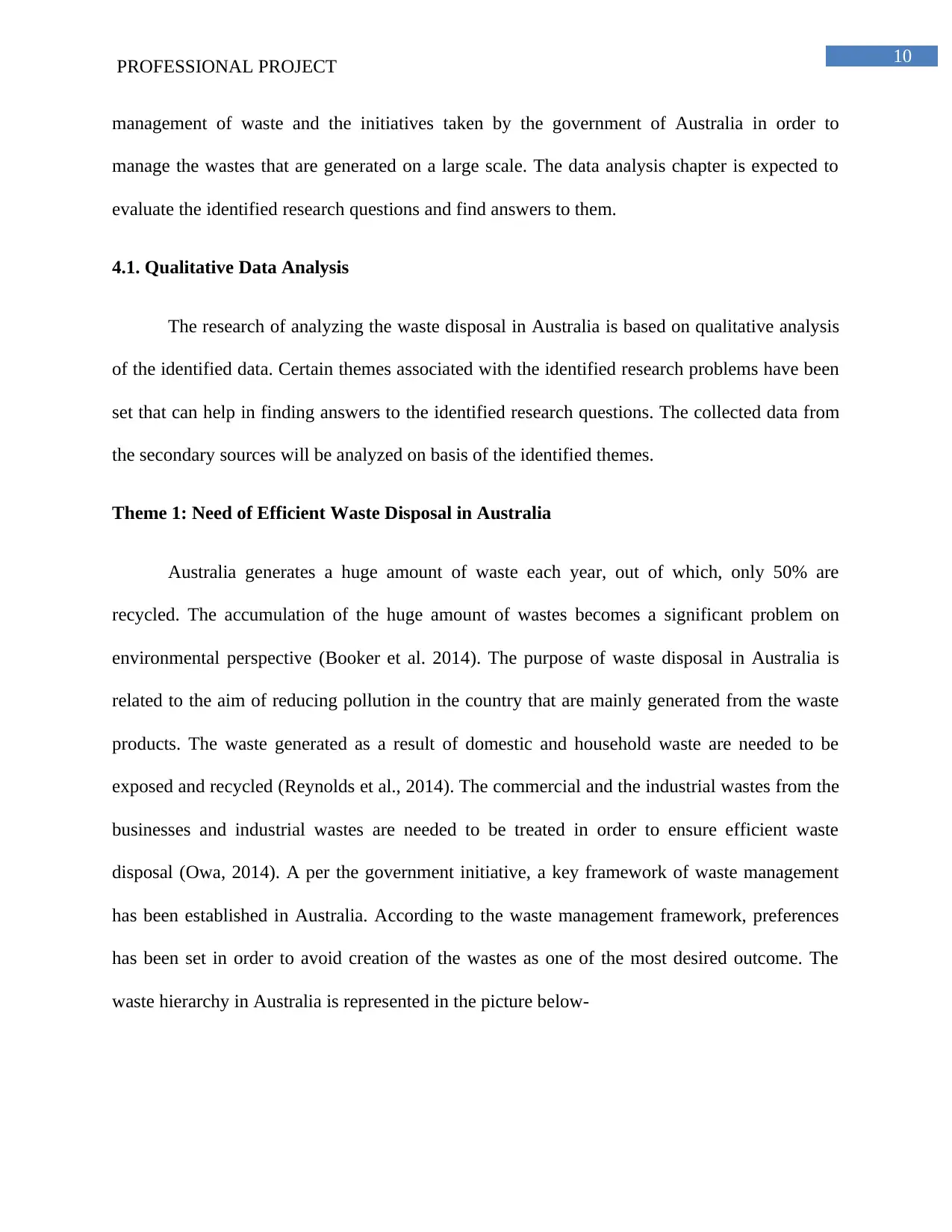
10
PROFESSIONAL PROJECT
management of waste and the initiatives taken by the government of Australia in order to
manage the wastes that are generated on a large scale. The data analysis chapter is expected to
evaluate the identified research questions and find answers to them.
4.1. Qualitative Data Analysis
The research of analyzing the waste disposal in Australia is based on qualitative analysis
of the identified data. Certain themes associated with the identified research problems have been
set that can help in finding answers to the identified research questions. The collected data from
the secondary sources will be analyzed on basis of the identified themes.
Theme 1: Need of Efficient Waste Disposal in Australia
Australia generates a huge amount of waste each year, out of which, only 50% are
recycled. The accumulation of the huge amount of wastes becomes a significant problem on
environmental perspective (Booker et al. 2014). The purpose of waste disposal in Australia is
related to the aim of reducing pollution in the country that are mainly generated from the waste
products. The waste generated as a result of domestic and household waste are needed to be
exposed and recycled (Reynolds et al., 2014). The commercial and the industrial wastes from the
businesses and industrial wastes are needed to be treated in order to ensure efficient waste
disposal (Owa, 2014). A per the government initiative, a key framework of waste management
has been established in Australia. According to the waste management framework, preferences
has been set in order to avoid creation of the wastes as one of the most desired outcome. The
waste hierarchy in Australia is represented in the picture below-
PROFESSIONAL PROJECT
management of waste and the initiatives taken by the government of Australia in order to
manage the wastes that are generated on a large scale. The data analysis chapter is expected to
evaluate the identified research questions and find answers to them.
4.1. Qualitative Data Analysis
The research of analyzing the waste disposal in Australia is based on qualitative analysis
of the identified data. Certain themes associated with the identified research problems have been
set that can help in finding answers to the identified research questions. The collected data from
the secondary sources will be analyzed on basis of the identified themes.
Theme 1: Need of Efficient Waste Disposal in Australia
Australia generates a huge amount of waste each year, out of which, only 50% are
recycled. The accumulation of the huge amount of wastes becomes a significant problem on
environmental perspective (Booker et al. 2014). The purpose of waste disposal in Australia is
related to the aim of reducing pollution in the country that are mainly generated from the waste
products. The waste generated as a result of domestic and household waste are needed to be
exposed and recycled (Reynolds et al., 2014). The commercial and the industrial wastes from the
businesses and industrial wastes are needed to be treated in order to ensure efficient waste
disposal (Owa, 2014). A per the government initiative, a key framework of waste management
has been established in Australia. According to the waste management framework, preferences
has been set in order to avoid creation of the wastes as one of the most desired outcome. The
waste hierarchy in Australia is represented in the picture below-
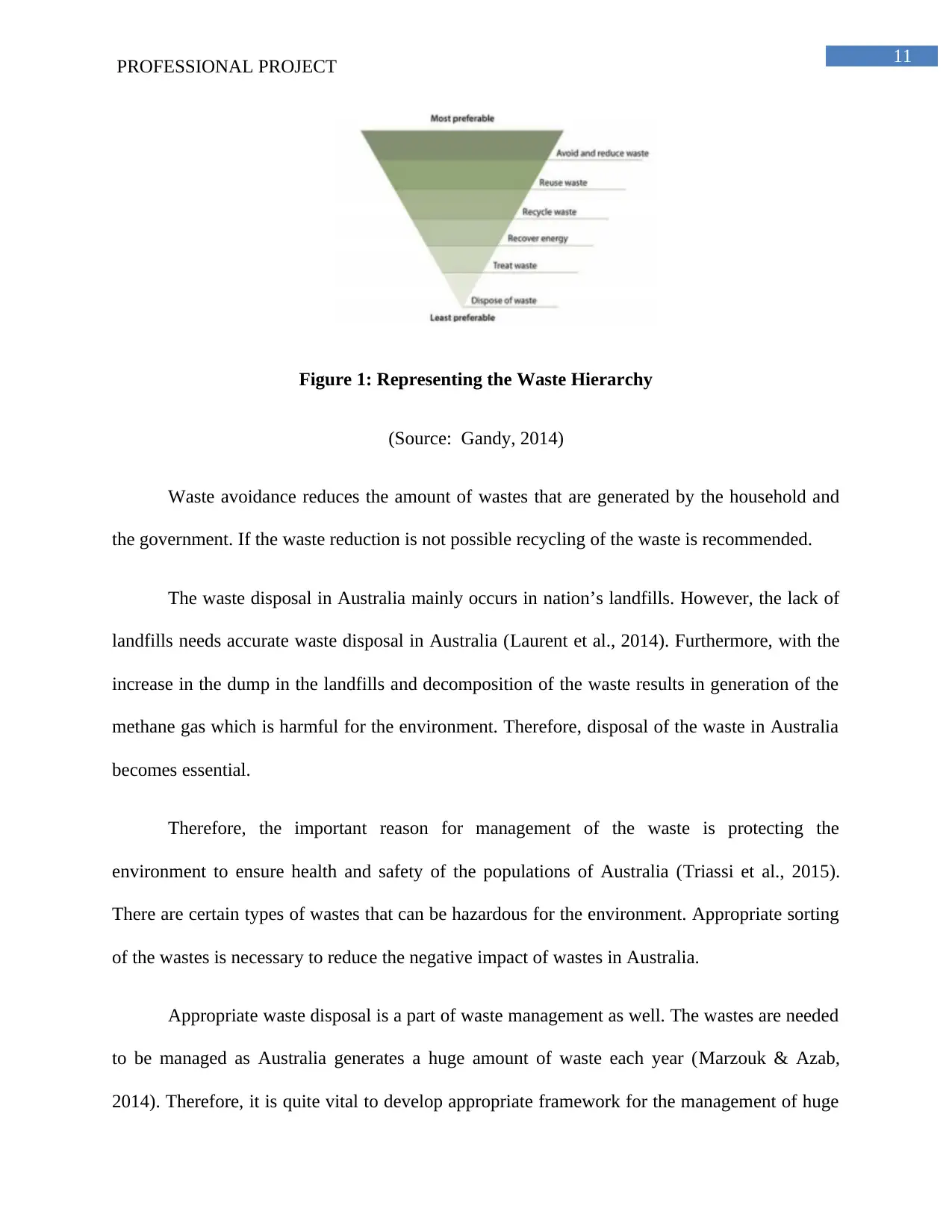
11
PROFESSIONAL PROJECT
Figure 1: Representing the Waste Hierarchy
(Source: Gandy, 2014)
Waste avoidance reduces the amount of wastes that are generated by the household and
the government. If the waste reduction is not possible recycling of the waste is recommended.
The waste disposal in Australia mainly occurs in nation’s landfills. However, the lack of
landfills needs accurate waste disposal in Australia (Laurent et al., 2014). Furthermore, with the
increase in the dump in the landfills and decomposition of the waste results in generation of the
methane gas which is harmful for the environment. Therefore, disposal of the waste in Australia
becomes essential.
Therefore, the important reason for management of the waste is protecting the
environment to ensure health and safety of the populations of Australia (Triassi et al., 2015).
There are certain types of wastes that can be hazardous for the environment. Appropriate sorting
of the wastes is necessary to reduce the negative impact of wastes in Australia.
Appropriate waste disposal is a part of waste management as well. The wastes are needed
to be managed as Australia generates a huge amount of waste each year (Marzouk & Azab,
2014). Therefore, it is quite vital to develop appropriate framework for the management of huge
PROFESSIONAL PROJECT
Figure 1: Representing the Waste Hierarchy
(Source: Gandy, 2014)
Waste avoidance reduces the amount of wastes that are generated by the household and
the government. If the waste reduction is not possible recycling of the waste is recommended.
The waste disposal in Australia mainly occurs in nation’s landfills. However, the lack of
landfills needs accurate waste disposal in Australia (Laurent et al., 2014). Furthermore, with the
increase in the dump in the landfills and decomposition of the waste results in generation of the
methane gas which is harmful for the environment. Therefore, disposal of the waste in Australia
becomes essential.
Therefore, the important reason for management of the waste is protecting the
environment to ensure health and safety of the populations of Australia (Triassi et al., 2015).
There are certain types of wastes that can be hazardous for the environment. Appropriate sorting
of the wastes is necessary to reduce the negative impact of wastes in Australia.
Appropriate waste disposal is a part of waste management as well. The wastes are needed
to be managed as Australia generates a huge amount of waste each year (Marzouk & Azab,
2014). Therefore, it is quite vital to develop appropriate framework for the management of huge
⊘ This is a preview!⊘
Do you want full access?
Subscribe today to unlock all pages.

Trusted by 1+ million students worldwide
1 out of 19
Related Documents
Your All-in-One AI-Powered Toolkit for Academic Success.
+13062052269
info@desklib.com
Available 24*7 on WhatsApp / Email
![[object Object]](/_next/static/media/star-bottom.7253800d.svg)
Unlock your academic potential
Copyright © 2020–2025 A2Z Services. All Rights Reserved. Developed and managed by ZUCOL.




